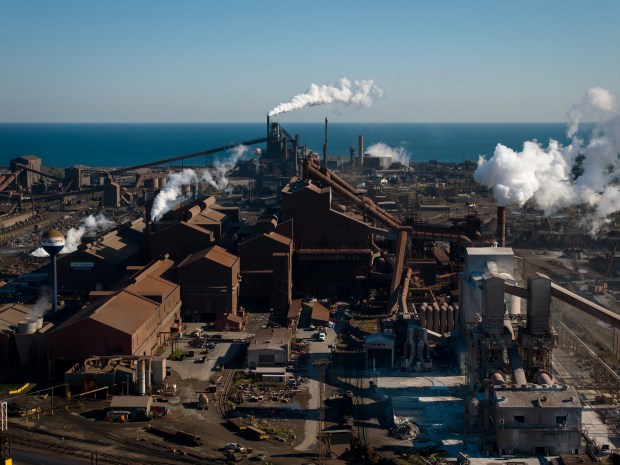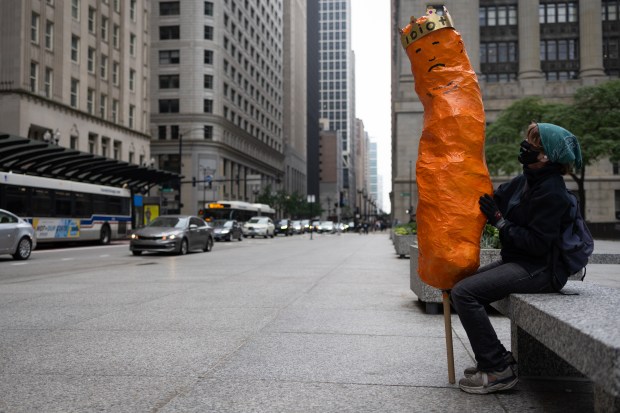WASHINGTON — As they seek effective attack lines against Vice President Kamala Harris, Republicans are focusing on her role in the Biden administration’s border and immigration policies, seeking to blame her for the surge of migrants into the United States over the past several years.
A review of her involvement in the issue shows a more nuanced record.
President Joe Biden did not assign her the job title of “border czar” or the responsibility of overseeing the enforcement policies at the U.S.-Mexico border, as the Trump campaign suggested Tuesday in its first ad against her. But she did have a prominent role in trying to ensure that a record surge of global migration did not become worse.
After the number of migrants crossing the southern border hit record levels at times during the administration’s first three years, crossings have now dropped to their lowest levels since Biden and Harris took office.
Her early efforts at handling her role and the administration’s policies were widely panned, even by some Democrats, as clumsy and counterproductive, especially in displaying defensiveness over why she had not visited the border. Some of her allies felt she had been handed a no-win portfolio.
Early in the administration, Harris was given a role that came to be defined as a combination of chief fundraiser and conduit between business leaders and the economies of Guatemala, Honduras and El Salvador. Her attempt to convince companies across the world to invest in Central America and create jobs for would-be migrants had some success, according to immigration experts and current and former government officials.
But those successes only underlined the scale of the gulf in economic opportunity between the United States and Central America, and how policies to narrow that gulf could take years or even generations to show results.
Rather than develop ways to turn away or detain migrants at the U.S.-Mexico border, Harris’ work included encouraging a Japan-based auto parts plant, Yazaki, to build a $10 million plant in a western Guatemalan region that sees high rates of migration and pushing a Swiss-based coffee company to increase procurement by more than $100 million in a region rich with coffee beans.
She convened leaders from dozens of companies, helping to raise more than $5 billion in private and public funds.
“Not a huge amount, but it ain’t chicken feed and that links to jobs,” said Mark Schneider, who worked with Latin American and Caribbean nations as a senior official at the U.S. Agency for International Development during the Clinton administration.
Jonathan Fantini-Porter, the chief executive of the Partnership for Central America, the public-private partnership Harris helped lead, said the money had led to 30,000 jobs, with another 60,000 on the way as factories are constructed.
She also pushed Central American governments to work with the United States to create a program where refugees could apply for protection within the region.
Still, some of Harris’ critics said her focus on the “Northern Triangle” countries of Guatemala, Honduras and El Salvador was a mistake.
Most migrants crossing the U.S.-Mexico border during the Obama and Trump administrations did come from those countries. But as migration from that region stabilized during the Biden administration, it exploded from countries such as Haiti, Venezuela and Cuba.
The Northern Triangle countries accounted for roughly 500,700 of the 2.5 million crossings at the southwest border in the fiscal year of 2023, a 36% drop from the 2021 fiscal year, according to the Wilson Center.
“They didn’t care to do a good diagnosis of the issue, and they have just focused on a very small part of the topic,” said Guadalupe Correa-Cabrera, a political science professor at George Mason University who has studied Latin American relations and their impact on migration. Correa-Cabrera said Harris had “failed completely” in her mission by following an outdated approach to tackling the root causes of migration.
Biden had a similar portfolio to Harris’ when he was vice president. He was in charge of addressing the economic problems in Central America by rallying hundreds of millions of dollars of aid for a region where the United States has a complicated legacy.
After helping fuel violent civil wars in the 1980s, the United States retreated before seeing peace reforms through, a move that partly set the stage for the corrupt politicians and criminal groups who would exploit the countries’ lack of economic opportunities, overwhelm regional police forces and eventually spur hundreds of thousands of migrants — many of them unaccompanied minors — to make the dangerous trek north.
But U.S. foreign aid initiatives have not always worked to deter migration. Over the years, some investments have been mismanaged and prioritized training programs over actual jobs that would keep would-be migrants in their home countries. Former President Donald Trump froze the foreign aid programs in 2019.
When Biden gave Harris the assignment to look into the root causes of migration, some of her allies worried she was being set up to fail. During her first trip to Guatemala City in 2021, she faced outrage from progressives and immigration advocates when she delivered a blunt message to migrants: “Do not come.”
Republicans criticized her when she brushed aside questions about why she had not yet visited the border.
“I’ve never been to Europe,” Harris said during an NBC News interview with Lester Holt. “I don’t understand the point you’re making.”
Her staffers aggressively sought to distance the vice president from the rising number of crossings at the border — a top concern for voters of both parties.
Rep. Henry Cuellar, D-Texas, who worked with Biden when he had the assignment as vice president, said her task was inherently connected to the record numbers of crossings at the border, even though he agreed she was not a “border czar” in charge of enforcement.
“I think she was supposed to be looking at the diplomatic root issues,” said Cuellar, who signed a resolution proposed by House Republicans criticizing Harris’ work on migration. “But again, you can’t talk about what happens in Central America without coming to the border itself. The focus is the border.”
“I think she did try to distance herself from that,” Cuellar added.
Ricardo Zúñiga, who served as State Department’s special envoy for Honduras, Guatemala and El Salvador, said Harris was essential in bringing together Latin American and American business leaders to drive investment in Central America.
Less than a week into her role, Zúñiga recalled, Harris sat with members of the national security team and economists from the Treasury Department. After a round of introductions, she quickly got into probing the personalities of the Latin American leaders with whom she would be interacting.
Zúñiga said he later watched her put the information she had collected into practice. In Mexico City, she connected with Mexican President Andrés Manuel López Obrador by expressing interest in the artwork at his presidential palace.
In Guatemala, she took a much more direct approach to President Alejandro Giammattei. She warned him last year about attempts to disrupt the handover of power of the newly elected president, Bernardo Arévalo, while also pushing him to help form programs that migrants could use to apply for refuge in the United States closer to their home countries.
“She was curious and asked many questions,” Zúñiga said. “She very quickly realized that we weren’t going to solve 500 years of problematic history in a single term.”
On Tuesday, Harris tried to hit back against Trump’s attacks. During a campaign rally in Georgia, she highlighted his effort to tank legislation that had bipartisan support that would have curbed illegal immigration. “Donald Trump,” she said, “has been talking a big game about securing our border. But he does not walk the walk.”




